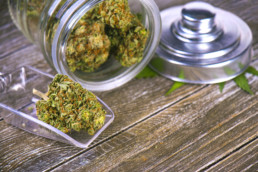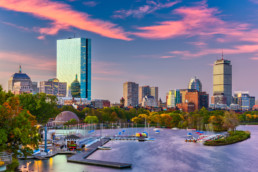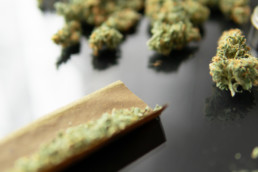Cannabis Concentrates 101
Cannabis concentrates are often confusing even for long-time consumers, largely because they cover a wide range of products with differences in everything from the form they take to how they’re consumed. Concentrates, which generally have THC levels around 50%, but can creep as high as 90%, are gaining popularity for their potency. Comparatively, cannabis flower commonly contains between 15%-25% TCH.
Solventless vs. Solvent Cannabis Concentrates
Concentrates represent a broad category of cannabis products and the easiest way to distinguish between them is how the concentrate is made: either with solvents or solventless. Products are then further distinguished by the type of solvent used and the consistency of the final product.
Solventless Cannabis Concentrates
As the name implies, solventless concentrates are produced without the use of solvents. Rather, they’re created using heat, pressure, and water to extract cannabinoids and terpenes from plant matter. Unlike what you learned in high school chemistry, water is not considered a solvent, and concentrates made using water are considered solventless. The most common solventless cannabis concentrates are hash and rosin.
Hash
Hash is the classic concentrate, dating back thousands of years. Traditionally, hash was made by rubbing buds together in your hands and rolling the resin left behind into balls or wads. Hash is made much more efficiently today using a variety of methods such as mechanized dry sieves, ice, and water. The use of water is a particularly popular method of making hash and the end product is commonly called “bubble hash,” thanks to the way it bubbles when smoked.
Rosin
Rosin is made by applying heat and pressure to cannabis flower and results in a rich, potent, syrup-like material that you can smoke or dab. Rosin is popular because it doesn’t use chemicals in the extraction and delivers a flavorful, powerful product. Rosin is popular for DIYers—you can make it using a hair straightener—but you’ll also frequently find it at a dispensary near you.
Solvent Cannabis Concentrates
Chemically, a solvent is a liquid that dissolves a solid to produce a solution. In cannabis, solvents are employed to extract terpenes and cannabinoids from plant material which is then removed, typically through vacuuming, evaporation, or hand whipping. Because the solvents used to make concentrates are often volatile, production is best left to professionals. Your local dispensary should stock a wide variety of concentrates made using solvents.
Numerous types of solvents are used to make concentrates—butane, CO2, propane, and alcohol are all common—and different solvents produce different end products.
CO2 Oil
One of the most common concentrates, CO2 oil is used in vape cartridges and disposable vape pens. CO2 oil is made by applying pressure and carbon dioxide to separate cannabinoids and other essential compounds from plant material.
Live Resin
CO2 is also used to make live resin, a concentrate made from just buds and fan leaves. Freshness is key (hence the “live” part), which is why live resin is made from cannabis frozen immediately after being harvested and kept frozen through extraction. Like other concentrates, live resin is potent and consumers love it for its intense flavor and aroma.
Tinctures
Tinctures are made using alcohol as a solvent. Tinctures typically come in a small bottle and are administered using a dropper, which makes them a discreet, easy-to-transport, smoke-free way to consume cannabis. Tinctures are commonly delivered sublingually, or under the tongue, but you can also mix them into food and drinks.
Butane Hash Oils (BHO)
This is the extraction method that you’ve likely heard horror stories about someone trying to make at home—butane (the primary solvent) is highly flammable and BHO production is best left to the pros. BHO results in numerous products which are defined by their texture and consistency.
- Shatter: known for its smooth, hard, translucent appearance and is noted for its similarity to glass. Shatter is generally a light or dark amber color and is easily broken into pieces.
- Crumble: often compared to a honeycomb and has a dull appearance. Crumble, as its name implies, is easily broken apart.
- Budder: also called “badder” and has a consistency similar to cake batter or a salve. Because of its malleability, in addition to being consumed using a dab rig, budder is sometimes spread on joints or blunts to up their potency.
- Sauce: super sticky and viscous, sauce’s consistency resembles that of marmalade. Unlike other BHO products, sauce contains two parts and possesses cannabinoid-rich crystals floating in terpene-rich oil. The end results in a potent and flavorful product.
- Wax: soft, gooey, and sticky, wax can come in a variety of consistencies, ranging anywhere from a slightly firm crumbly texture (similar to crumble) to a more sludgy quality reminiscent of budder.
Cannabis Concentrate Dosing
The majority of concentrates are extremely strong and work very quickly. This makes it a great choice for experienced users, but also makes it very easy to overdo it. When purchasing concentrates at your local dispensary, make sure you know the strength of what you’re buying and the size of a dose. Another option is to purchase pre-filled vape cartridges or disposal vapes, which make it easy to control the dose.
Lowkey Dispensary
Whether you’re looking for some flower to make your own hash or some top-quality budder, Lowkey Dispensary is the place to go. We stock a wide variety of both solvent and solventless concentrates along with the accessories you need like vapes and dabs. Our experienced staff can even assist you in finding the concentrate with the right potency and dose for you before leaving.
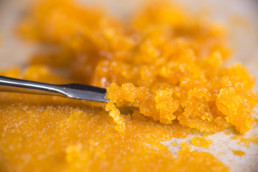
Sign up to our newsletter
Enter your email to receive the latest news, events, and product specials!
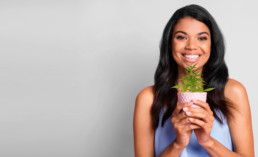
Lowkey A Lowkey Guide to Storing Cannabis
Not so long ago, storing your weed in a plastic baggie was the norm. But as users get more sophisticated, so is how they store their weed. Proper storage of marijuana is key to maintaining its quality, ensuring you get the flavor and potency you pay for, and maximizing the investment you made at your local dispensary.
The Importance of Properly Storing Cannabis
How long does weed last? According to one study, cannabis has a shelf life of up to two years provided it’s cured and stored properly. In states with legal recreational marijuana—like Massachusetts, home of Lowkey—curing is commonly done before the weed arrives at your local dispensary; after you purchase a cannabis product, though, the responsibility to store it the right way falls on you.
The 5 Rules of Cannabis Storage
The key to preserving your pot’s flavor, aroma, quality, and potency largely comes down to limiting its exposure to the elements. In general, the more you can control the environment cannabis is stored in and the cleaner you keep where it’s stored, the better.
1 – Stay Cool
Ideally, weed is stored in temperatures ranging from the mid-fifties to mid-seventies. Store it in too-hot conditions and you can dry out the flower and reduce terpenes, the compounds that give cannabis strains their unique smell and taste. Furthermore, temperatures above the mid-seventies, when combined with excess humidity, are conducive to mold and mildew—the enemy of safe and healthy cannabis.
Too-cold temperatures are also bad for the longevity of weed. Freezing cannabis can damage its trichomes—appendages that produce and store the plant’s cannabinoids and terpenes—and ultimately affect its potency.
2 – Keep it in the Dark
Store weed in a dark place—somewhere like a closet/drawer or, at a minimum, in an opaque container. Light (sunlight in particular) is the biggest threat to your weed. UV degrades cannabinoids and terpenes and reduces its potency. A study from the 1970s found that exposure to light is the greatest single factor in the loss of cannabinoids.
3 – Manage Moisture
In a perfect world, weed is stored in a relative humidity of 59% to 63%. When humidity levels creep above 63%, your bud becomes more susceptible to mold and mildew—the natural enemy of cannabis. Conversely, not enough humidity can dry out weed and break down cannabinoids and terpenes. Too-dry conditions can also strip cannabis of essential oils and can lead to weed that lacks flavor, is harsh to smoke, and is less potent.
4 – Clear the Air
Storing your weed in an airtight container can go a long way to ensure long-lasting cannabis. Air converts THC (tetrahydrocannabinol) to CBN (cannabinol). More simply, air reduces the “high” feeling produced by THC and replaces it with the more sedative effect of CBN.
Another tip for controlling the amount of air in contact with your weed is to choose the correct container size. A good rule of thumb is that your weed should take up between two-thirds to three-quarters of its container. This leaves some room for air and prevents humidity from rising, but doesn’t pack your bud so tight that it gets damaged.
5 – Clean Up
Keeping the container you store your cannabis in clean is an easy way to prolong its shelf life and ensure its quality. Make sure to remove any dirt and grime before adding your weed. It’s also a good idea to clean containers between uses if you’re mixing strains, since containers can hold onto flavors and impart them on whatever they’re currently holding. While not catastrophic, it can affect the taste and your overall experience.
Recommendations for Storing Weed
Plastic baggies have gone by the wayside, but there are numerous options available, ranging from repurposing common household goods to buying something especially for weed storage.
Glass Mason Jars
Glass Mason jars are an extremely popular choice for storing weed. Glass is sturdy, nonporous, and—unlike metal and plastic—will not affect the smell and taste of your weed. Mason jars also feature an airtight seal which helps your bud last longer.
On the downside, classic Mason jars are clear and do not block light, the biggest threat to weed. If you’re going to use Mason jars to store your weed, keep them someplace where they won’t get exposed to light. Another option is to select Mason jars made with brown glass—which offers significantly more protection from light than clear—or made with UV-resistant glass.
Cannabis Humidor
Cannabis humidors—humidity-controlled boxes—are gaining popularity with true marijuana mavens. If you’re going to go this route, buy a humidor specifically made for use with weed. Cigar humidors are lined with cedar, which has oils that enhance the flavor of cigars but can have the opposite effect on cannabis. Cigar humidors also use sponges that use propylene glycol to control humidity, which can oversaturate your pot.
Other Considerations
In addition to what you store your weed in, there are a few other factors to consider when storing weed.
- Moisture control: A multitude of companies have stepped up to create ways to keep your cannabis at the correct humidity level. Look for pods or packs that absorb and release moisture as needed.
- Store separately: Keep your weed away from lighters, pipes, grinders, and other paraphernalia that can impart their smell on your container and in the end your weed.
The Wrap Up
Lowkey Dispensary sells the finest cannabis products and proper storage of them ensures the best possible experience. While nothing lasts forever, taking a little extra care when storing your pot can help it last longer, smell and taste better, and protect its potency.
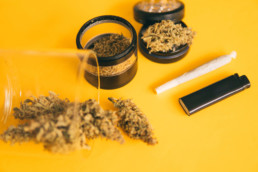
Sign up to our newsletter
Enter your email to receive the latest news, events, and product specials!

Lowkey Dispensary - Opening March 2022
Our goal is to provide cannabis products and education to help you make the most of your everyday experiences. Lowkey is opening March 2022 in Dorchester MA.
Nine Cannabis-Related New Year Resolutions
Nine Cannabis-Related New Year Resolutions
The tradition of making New Year’s resolutions dates back almost 4,000 years to the Babylonians. It’s said they made promises to the gods in hopes they’d earn good favor in the coming year. The practice of making New Year’s resolutions remains ever-present today, although more often in the spirit of self-improvement than currying favor with the spiritual world. If you’re a cannabis connoisseur, here are 9 ways to make 2022 the best year yet for you and Mary Jane.
1. Try Something New
We’re living in the golden age of weed. There are more cannabis products today than ever, and they’ve never been more accessible. One in three Americans lives in a state where recreational marijuana is legal. This New Year, resolve to try new ways to ingest cannabis—for example, if you’re a smoker, make this the year to try edibles or concentrates. Another way to mix up your cannabis consumption is to try a different strain of weed. Your local dispensary can recommend a strain to meet your preferred flavor/aroma profile, potency, and desired effects.
2. Cook with Cannabis
Gone are the dark days of making guesswork homemade pot brownies that resulted in snacks ranging in strength from humdrum to hair raising. Products like cannabis-infused butter, flour, and sugar have made it easy to cook with cannabis from the comfort of your own kitchen. Pick up one of any number of great cannabis cookbooks to get started or swing into your local dispensary for inspiration. Shops like Lowkey Dispensary are stocked with a cornucopia of cannabis edibles.
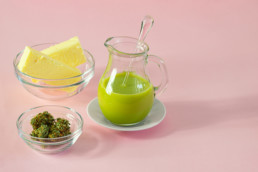
3. Eat Healthy Munchies
Marijuana and munchies go hand in hand; when the brain interacts with THC, it stimulates the appetite. For most of us, our natural inclination is to reach for sweet, salty, and generally unhealthy food when the munchies strike—pizza, chips, and chocolate all immediately spring to mind. However, keeping healthy snacks like fresh fruit, nuts, or air-popped popcorn (not like the stuff from the theater slathered in butter and salt) is a simple step to a healthier year ahead.
4. Get Active
The munchies are an easy way to pack on the pounds over the course of the year, especially when combined with inactivity. Getting high and kicking back with your favorite movie, video game, or music are favorites, but consider pairing cannabis with exercise. After all, the World Anti-Doping Agency considers cannabis a performance-enhancing drug. A study by the University of Colorado Boulder found that 80% of marijuana users in states where cannabis is legal use it shortly before or after exercise, reporting it increases enjoyment, improves recovery, and serves as motivation.

5. Show More Generosity
Nothing kills a good time faster than the person always showing up empty-handed. If you haven’t been contributing to smoke sessions, this is the year to turn it around. If you don’t have easy access to weed—for example, Lowkey is an hour from both New Hampshire and Rhode Island, two states where recreational marijuana remains prohibited—no worries, just bring the snacks instead.
6. Break Stereotypes
There’s no shortage of stigmas about cannabis users—it’s common for people to characterize pot people as lazy, unmotivated, forgetful, and easily confused. Of course, that isn’t the case. Successful marijuana enthusiasts include people like:
- Bill Gates, co-founder of Microsoft
- Michael Phelps, winner of 23 Olympic gold medals
- Steve Jobs, co-founder of Apple
- Ben Cohen and Jerry Greenfield, co-founders of Ben & Jerry’s Ice Cream
- Redman and Method Man, rappers and actors
Make this the year that cannabis is associated with smart, ambitious, healthy, and successful people.
7. Cannabis and Creativity
The connection between cannabis and creativity has a long and storied history, although there is little scientific proof of cannabis as creative fuel. That said, a 2017 study found that marijuana users are more likely to have creative personalities. Turn off the television, tackle an art project, and keep your right brain busy. Painting, drawing, writing short stories or poetry, and even an adult coloring book are great ways to keep your artistic side active while consuming cannabis.

8. Make a Difference
There are a lot of great organizations working toward making the world of cannabis a better place and they need support—from groups working to legalize weed to those creating a more equitable industry to those trying to expunge the offenses of those with cannabis-related crimes. Commit to helping one of these causes this year, whether it’s with funding, showing up to a march, or a letter-writing campaign.
9. Support Your Local Dispensary
Beyond the convenience of having a dispensary in your neighborhood, there are a lot of great reasons to support your local dispensary. Building a relationship with your local budtender can lead to more reliable and effective recommendations and an increased personalization of service.
Dispensaries like Lowkey, in Dorchester’s Codman Square, are also adding value to the community. Lowkey is renovating an older building, hopes to stimulate business in the area, and is initially adding about 30 jobs that we hope to fill with local employees.
Lowkey is also importantly bringing minority representation to an industry that is overwhelmingly white. When we open this Spring, Lowkey will be just the second Black-owned dispensary in Boston and one of ten (out of 280) cannabis business licenses awarded in Massachusetts that have gone to Economic Empowerment or Social Equity applicants.
Ready to Start Your Order Shop Lowkey Dispensary's Products Online
Our goal is to provide cannabis products and education to help you make the most of your everyday experiences and live Lowkey!
Sign up to our newsletter
Enter your email to receive the latest news, events, and product specials!

Lowkey Social Justice and the Cannabis Industry
Lowkey Social Justice and the Cannabis Industry
In what seems like the blink of an eye, cannabis has gone from a prohibited substance to a profitable product. Recreational cannabis is currently legal in 19 states along with Washington, D.C., and the future is bright for cannabis—the state-legal cannabis industry is now estimated to be worth over $18 billion and supports more than 300,000 full-time jobs. The future is also white. A 2017 survey found that 81% of cannabis business owners and founders were white, while 4.3% were Black, a particularly disparate proportion considering that people of color have been disproportionately affected by the war on drugs.
For the cannabis industry to become socially equitable, it’s vital that Black-owned businesses like Lowkey Dispensary succeed and help increase the inclusion of minorities in this rapidly expanding industry. Last year, the cannabis industry added 77,300 jobs, a 32% increase in year-over-year growth, a faster job growth rate than any other industry in the U.S.
What is Social Equity?
Social equity can mean different things to different people. In the cannabis industry, it’s generally focused on the meaningful participation of those who’ve been unfairly impacted by marijuana prohibition and enforcement. According to the American Civil Liberties Union (ACLU), Black Americans are arrested for cannabis offenses at almost four-to-one compared to whites—a rate that has gone almost unchained for a decade.
Even in places like Massachusetts—home to Lowkey Dispensary—Black people were four times as likely as white people to get arrested for marijuana possession between 2010 and 2018, despite the state decriminalizing marijuana in 2008 and legalizing it in 2016. Black-owned dispensaries like Lowkey are crucial to overcoming the damage done to the Black community by discriminatory law enforcement.
Social equity is one of the reasons why we’re set to open our first location in Codman Square, Dorchester, a neighborhood where 40% of the residents are Black. It’s also why we’re committed to hiring candidates from within the neighborhood and training them for long-lasting careers in the cannabis industry, a market that is expected to top $90 billion by 2028.
The War on Drugs and People of Color
The 1930s
The war on drugs has historically coincided with a war on people of color. The first director of the Federal Bureau of Narcotics, Harry Anslinger, was appointed in the 1930s. Anslinger left behind a legacy of racist rhetoric and is known for helping to popularize the word “marijuana,” something he used to tie cannabis to Mexican immigrants.
The 1970s
In the 1970s, the Nixon administration established the Drug Enforcement Administration (DEA). The intention of the agency was to target illegal drug use and smuggling in the U.S., but history has shown an ulterior motive—in a 1994 interview, President Nixon’s domestic policy chief explained that the Nixon campaign had two enemies: “the antiwar left and Black people.”
He went on to say: “We knew we couldn’t make it illegal to be either against the war or Black, but by getting the public to associate the hippies with marijuana and Blacks with heroin, and then criminalizing both heavily, we could disrupt those communities. We could arrest their leaders, raid their homes, break up their meetings, and vilify them night after night on the evening news. Did we know we were lying about the drugs? Of course, we did.”
The loser of the war on drugs that began in the 1970s is the American people and especially people of color. The incarceration rate of Black people in the U.S. shot up from about 600 per 100,000 people in 1970 to 1,808 in 2000.
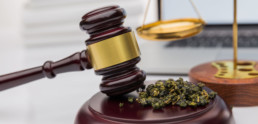
The Present Day
Today, despite minorities and white people using and selling drugs at similar rates, the percentage of incarcerated people is completely out of whack. Almost 80% of people serving time for a federal drug offense are Black or Latino and people of color make up 60% of those serving time for drug charges in state prisons.
Black Ownership of Cannabis Businesses
Black people and their communities have paid a heavy price in the 50 years following the war on drugs—and as more and more states move to legalize cannabis, it’s imperative that those most hurt by cannabis prohibition reap some of the rewards of its legalization. Unfortunately, so far this isn’t the case.
A 2021 report found that only 2% of America’s estimated 30,000 cannabis companies are Black-owned, but Black Americans hold business equity in only 1 in 50 cannabis companies. A large amount of funding is often required to start a cannabis business, yet because cannabis remains illegal federally, finding financing is extremely challenging—meaning cannabis owners need access to considerable capital, something challenging to locate in communities where the war on drugs limited employment opportunities, and something not easily accomplished for those coming from communities that have been subjected to practices like Jim Crow, redlining, and bank loan denials.
It’s just not equity where Black people are underrepresented in the cannabis industry. In Massachusetts, 73.5% of staff at cannabis companies identify as white. Black cannabis business ownership and Black-owned dispensaries are key to introducing more people of color to the cannabis industry.
Building Back Better Black Communities
Black ownership is vital to creating an equitable industry and building wealth into communities ravaged by the war on drugs. Dispensaries like Lowkey not only build equity in the cannabis industry, but also open doors and create careers for Black people in an industry that’s predominantly white. Our Dorchester location will also drive traffic, revitalize business, and spur economic activity in a largely Black community.
Lowkey Dispensary
Lowkey is on track to open our Dorchester location early this winter and is already working on securing a second location in West Roxbury. We hope to see you in the shop when we open and want our customers to know that by shopping Lowkey, they’re not just purchasing a product but supporting the Black community and contributing to social equity in one of the fastest-growing industries in the nation.
Sign up to our newsletter
Enter your email to receive the latest news, events, and product specials!

What is Cannabis Dabbing and How to Dab Marijuana
What is Cannabis Dabbing and How to Dab Marijuana
Roughly 44% of the U.S. population lives in a state where it is legal, or soon will be legal, to consume cannabis recreationally. As cannabis becomes more commonplace, so does the familiarity users have with the popular methods of consumption such as joints, edibles, and pipes. One less familiar, but increasingly popular, way to consume cannabis is by dabbing.
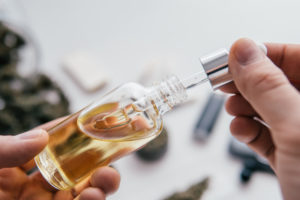
What is Dabbing?
At its most basic, dabbing is the consumption of concentrated cannabis (a dab) through vaporization. Driving the interest in dabbing is that cannabis extracts generally contain very high levels of tetrahydrocannabinol (THC), which makes it one of the fastest and most efficient ways to feel the effects of marijuana.
Dab Rig
The classic way to dab is with a dab rig—a water pipe similar to a bong specifically designed for use with concentrates. A dab rig consists of a few parts:
- Pipe: the chamber, or chambers, which dab vapors run through
- Nail: the piece that the cannabis extract is heated on; commonly constructed from titanium, ceramic, quartz, or glass
- Dabber: the dentist-like tool—generally made of glass or metal—used to apply the concentrate on the nail
- Blowtorch: used to heat the nail; butane torches are popular but many dabbers use torches specially designed for dabbing (it’s worth noting that some dab rigs feature an electronic, nail which allows for flameless operation)
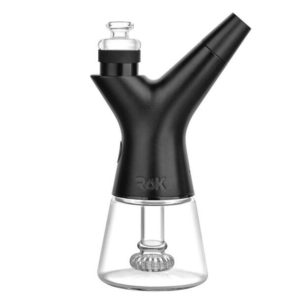
There’s some debate among those who dab over the merits of using a dome with a dab rig’s nail. Proponents argue that a dome makes the rig safer and helps retain vapor. Detractors argue that a domeless dab rig is simpler and allows for bigger hits. Domeless dabbers commonly employ a carb cap to help control the temperature of the dab for a cleaner taste.
Dab Pens/Vape Pens
Heating the nail with a blowtorch is intimidating, especially for many first-time dabbers, which is one reason for the popularity of torchless dabbing devices like pens and vaporizers that use a heating element, rather than a flame, to heat the cannabis concentrate. Other reasons users favor dab pens are that they’re easy to operate, portable, and discrete—similar to other types of vape pens or e-cigarettes, they’re easily stashed in a pocket.
Types of Dabs
Cannabis concentrates can take a variety of forms depending on how the oil was processed after extraction. Common types of dabs include:
- Shatter: Thin and semi-transparent, shatter looks like an amber-tinted pane of glass and is typically thought of as one of the purest extracts.
- Butter/Budder: Similar in texture to peanut butter, but with an amber/yellowish color, butter or budder, is known for its ease of consumption and storage.
- Wax: Alike in appearance to a candle or ear wax, wax is popular for its appealing smell and flavor, easy handling and storage, and its potency.
- Oil: This thick, dark gold liquid (sometimes also called honey oil) is produced using carbon dioxide instead of butane, leaving it with a distinct taste.
- Distillate: A unique tasteless and odorless oil that is devoid of compounds other than THC, making it extremely potent.
- Rosin: Created by applying heat and compressions to the bud of a cannabis flower, rosin is a sticky substance that doesn’t contain any solvent residue, making it favored by users who prize flavor and purity. Rosin is sometimes confused with live resin.
- Live resin: A sticky matter with textures varying from sappy to jellyfish, live resin is a favorite of users who value flavor and aroma, in addition to effects.

The Benefits of Dabbing
Marijuana users find that dabbing professionally produced cannabis concentrates procured from their local dispensary offers several advantages over other methods of consumption:
- The effects are felt swiftly and the effect is potent
- Since dabs contain no plant material, they are cleaner tasting, smoother, and contain fewer compounds compared to smoking
- It’s a more efficient means of consumption than the 10-15 minutes it takes to smoke a joint or bowl, or the 30 minutes to two hours it can take for edibles to kick in
- Dab vapor has a much more subdued smell than distinctly scented marijuana smoke, making it a more inconspicuous option, especially when consumed using a vape pen
- Cannabis concentrates are more expensive than other forms of cannabis, but thanks to the small amounts required to achieve effects, they’re often the most cost-efficient method to consume marijuana
The Downside of Dabbing
The quality that draws many to dabbing is also its greatest drawback: dabs are strong. Cannabis extracts often contain between 70% to 90% THC; conversely, in 2015, researchers found the average THC level of legal marijuana in Colorado was 18.7%. The combination of quick effects and strong potency adds up to a form of marijuana that is very easy to go overboard with, no matter if you’re a new or experienced cannabis user.
If you’re new to dabbing and want a positive first experience, it’s advisable to start slow with a tiny amount.
Get Dabs from Your Local Dispensary
Even though it’s somewhat common to come across homemade dabs and DIYers can easily find directions to make do-it-yourself dabs, it’s best to get your dabs from
your local dispensary. First and foremost, making your own dabs is dangerous and more than one person has blown up their house (and gotten into heaps of legal trouble) trying to make their own cannabis concentrate.
In addition to eliminating the danger of production, the professionally made dabs available at a dispensary near you also are also transparent about how they are made and the amount of TCH they contain.
Lowkey Dispensary
Lowkey Dispensary is a trustworthy source of all your cannabis needs and stocks everything required to get started dabbing—from dab rigs and pens to shatters and waxes to accessories such as blowtorches. Our trained staff can even offer advice to help you find the right method, form, and strain to get the dab experience you want.
Sign up to our newsletter
Enter your email to receive the latest news, events, and product specials!

Cannabis Real Estate: Purchasing Dispensary Space
Recreational cannabis is growing quickly. For example, in Massachusetts (home to Lowkey Dispensary), recreational cannabis sales topped $2 billion less than three years after the first dispensary opened its doors—only a little less than a year ago, the state passed the $1 billion mark. Massachusetts is now home to 165 cannabis retailers and while numerous factors will affect their long-term success, a critical element is whether they own or lease their space.
Buying Cannabis Real Estate
Cannabis real estate is a tricky proposition and if you’re looking to open a dispensary, there are numerous hurdles you must clear to simply secure a location. Everything from state and local regulations to recalcitrant property owners to a tight supply of suitable locations can make just finding an acceptable storefront a challenge. While leasing provides a low-cost and often easier solution to finding a location for your dispensary, owning the property your dispensary is on can be a boon for the long-term health and success of your business.
Buying property for a cannabis dispensary offers numerous advantages, but isn’t without its drawbacks. Understanding the reasons why to buy and how it will build a foundation for the future of your business is a key step in starting a successful dispensary.
The Pros and Cons of Buying Cannabis Real Estate
The Pros of Buying Cannabis Real Estate
In many states, the license to sell recreational cannabis is tied as much to location as it is an operator. For example, in Massachusetts a “licensee is limited to performing operations at a single location,” which must be secured by either buying or leasing property to even apply for a license. This can mean your location sits empty for an extended period of time while your license awaits approval and a storefront is built. Owning a location that has been approved to sell recreational cannabis is a valuable commodity and the equity you accrue on it can help offset the expense of an empty space during the startup stage.
The numerous restrictions and regulations governing recreational marijauna dispensaries, in combination with a limited number of locations that offer the characteristics of a flourishing retail shop, have created an imbalance between the demand and supply of potential property for dispensaries. There simply aren’t enough locations that deliver the accessibility, visibility, and traffic that a retail operation needs, while also meeting municipal requirements for operating a dispensary (such as being at least 1,000 feet away from schools, public parks, and hospitals). Possessing one of these scarce properties provides you with financial flexibility and creates the possibility of renting the property to another dispensary in the future.
Another reason for owning the property your dispensary is housed in is that you stand to benefit from any economic improvement brought about by your dispensary.
Dispensaries create jobs, increase tax revenues, and drive up property values. A 2021 study found that home values increased $22,090 more in cities with recreational dispensaries, compared to home values in cities where recreational marijuana is legal but dispensaries are not available—with each new dispensary a city adds, property values increase by $519. A survey from the National Association of Realtors found that 13% to 22% of respondents saw an increase in commercial property values near marijuana vendors in their markets.
Lastly, buying your dispensary’s property is a smart hedge against a shift in cannabis policy. If, for some reason, operating your dispensary becomes legally unfeasible, you can convert the property to court another retailer or different type of business.
The Cons of Buying Cannabis Real Estate
The biggest downside to purchasing cannabis real estate is finding funding. Because cannabis is illegal on the federal level, federally insured banks and other lenders will generally not finance cannabis real estate. In order to purchase a piece of property for your dispensary, you’ll need to have access to a considerable amount of capital or have an investor(s) lined up.
While the absence of appropriate inventory is a benefit, it’s also a challenge. Demand for high-quality dispensary locations outstrips supply, which drives up property prices, that is if you can even find a suitable space. The aforementioned National Association of Realtors survey reported an 18% to 19% increase in demand for cannabis storefronts in states where both medicinal and recreational marijuana were legal.
Great retail locations are hard to find—even more difficult if you’re a cannabis retailer—and the right location can make a difference between being in the red or rolling in green. Unfortunately, the best retail locations are not always for sale or fetch a premium price. A willingness to lease, rather than buy, can increase the number of location options and may offer a location better suited to success.
Why We Buy
Lowkey Dispensary believes in purchasing our property, not just as business decisions but as a commitment to the community. When we acquire a property, we’re not just buying a storefront for a dispensary, we’re investing in the surrounding neighborhood by adding jobs and creating pathways to careers in cannabis. Lowkey is one of the few Black-owned dispensaries in the Boston area and is dedicated to improving minority representation in the recreational marijuana industry—Black and Latino people make up less than 12% of the marijuana workforce in Massachusetts, comparatively White people make up nearly 75%.
Sign up to our newsletter
Enter your email to receive the latest news, events, and product specials!

The Challenges of Cannabis Real Estate
Recreational marijuana is currently legal in 18 states and Washington, D.C., and has passed through a ballot measure in South Dakota—although a lawsuit has so far prevented it from going into effect. According to 2020 U.S. Census Bureau apportionment numbers, more than 145 million Americans now live in a state that has legalized marijuana. This all adds up to a rising interest in cannabis real estate, particularly in retail. One of the most important decisions facing recreational cannabis businesses is where to set up shop.
The Challenges of Cannabis Real Estate
It’s estimated that cannabis businesses will contribute $130 billion to the U.S. economy by 2024, yet finding and securing real estate is one of the largest hurdles facing cannabis companies. One of the primary challenges to finding cannabis-friendly real estate is regulations—federally, on the state level, and locally.
Federal
While the number of states with legalized cannabis continues to grow, it remains illegal federally, which makes opening a recreational cannabis dispensary more challenging than other types of retail operations. One of the most notable problems created by this is that it builds a barrier to funding. Most dispensaries struggle to find a bank willing to lend them money, which means they’ll need to find investors or have a large amount of capital available to them.
Because leasing is often less costly in the short term, this pushes many dispensaries down this path, even if it’s not always the best long-term business solution.
State
States also place a burden on retail cannabis businesses. For example, in places like Massachusetts, where Lowkey Dispensary is set to operate, a retail cannabis shop must have secured a site—whether they own it, have the option to purchase it, or have signed a lease—before they can acquire a license. This commonly means that retailers are sitting on an unoccupied property or paying a lease on a space that isn’t generating any income while they move through the licensing process and build out their spaces.
If the license doesn’t come through, it’s a huge loss—particularly for those who have signed a lease. Those who own a piece of property at least have potential to rent it to another business or to try and flip the property.
Local
Even after a recreational cannabis dispensary overcomes the federal and state-level real estate challenges, it also must ensure it conforms to local regulations, guidelines, and restrictions, which vary from community to community. There are 351 municipalities in Massachusetts (where Lowkey Dispensary operates), each with its own codes and regulations. In Massachusetts, municipalities can control the number of licenses it awards, the zones where they can operate, and in some cases even restrict dispensaries altogether.
Because of the strict number of licenses awarded, limitations placed on where a dispensary can operate, and the need to have secured a location to attain a license, there are limited location options to place dispensaries. This may push even those wanting to buy a space into leasing due to the lack of inventory.
Additional Real Estate Challenges Facing Cannabis Dispensaries
In addition to federal, state, and local regulatory challenges, there are a host of other issues commonly encountered by those trying to establish a retail cannabis location.
Wary Landlords and Sellers
For some landlords and sellers, there is a stigma around cannabis, which makes securing a location even more difficult. For operations looking to lease, some landlords are simply unwilling to rent to cannabis dispensaries, while others like large shopping centers with well-known national chains have tenants with clauses preventing them from renting to businesses like cannabis dispensaries. Even when a landlord is willing to rent to a dispensary, it’s not uncommon that they will pay a higher-than-market rent.
Operations looking to purchase property can also run into people with a reluctance to do business with a cannabis company. While most sellers will be excited to unload a property, there’s a chance of running into one with strong feelings about cannabis or their community who is willing to hold out for another buyer.
High Demand and Low Supply
The cannabis business is booming around the country—and in Massachusetts, where recreational marijuana sales in Massachusetts recently surpassed $2 billion. Big business and a limited number of locations that comply with state and local locations have led to a tight real estate market. There is simply more demand for cannabis dispensary real estate than available inventory.
The imbalance between supply and demand forces up-and-coming dispensaries to make a difficult decision: wait for just the right space or settle for good enough? Or, perhaps it pushes a willing property buyer to settle for a lease.
Why Buy
Every business is different, but at Lowkey, we believe in owning our location. This is why we bought and are in the process of fully renovating our Codman Square, Dorchester, location—the former home of a restaurant. We see owning the property we operate on offering our business several advantages
The most notable of those advantages is that, since there’s a tight supply of locations that meet all the regulations and codes required of a dispensary, even if things don’t work out for your cannabis dispensary, you’re well-positioned to serve as a landlord. If your business (or one you rent to) is a success, it can stimulate economic development, attract other businesses, and increase the value of your property.
Buying property is also a hedge that the increasingly liberal thinking about cannabis continues. If for some reason your dispensary becomes legally unfeasible, your dispensary’s property remains an asset and can be converted to home another type of business.
About Lowkey Dispensary
Another reason for purchasing our location in Dorchester’s Codman Square is that it shows we’re buying into the community. As one of only a few Black-owned dispensaries in Massachusetts, we’re committed to the neighborhood we operate in. We’re excited to bring a Black-owned business to a neighborhood where over 40% of the residents are Black, creating good jobs, and putting our employees on a path to success in the cannabis industry—an industry that has left minorities behind, nearly 75% of the Massachusetts marijuana workforce is white.
Sign up to our newsletter
Enter your email to receive the latest news, events, and product specials!

Lowkey Events & Experiences!
Lowkey is happy to announce the introduction of its lifestyle events and experience program!
At Lowkey we will constantly hold fun and engaging events and community gatherings which can be made more enjoyable when paired with cannabis. We will help host and provide events, entertainment, and general planned activities on scheduled dates. We will then engage with cannabis to make the best of these privately held events. Events will be posted on our website and will have limited capacities. If you would like to receive more information and be notified when events will take place, please enter your email below.
Sign up to our newsletter
Enter your email to receive the latest news, events, and product specials!

The Difference Between a Joint, Blunt, and Spliff
The Three Types of Cannabis Rolls: Joints, Blunts, and Spliffs
Cannabis culture has its own distinct language and while an outsider may think that terms like joint, blunt, and spliff are interchangeable, there are some distinct differences between the three. Before heading to your local dispensary, brush up on the lingo and understand the unique characteristics of the three broad categories of rolled cannabis.
What is a Joint?
Joints are arguably the most classic way to smoke marijuana. A joint is simply any strain of cannabis, with no filler, rolled inside a thin rolling paper and often features a crutch—a filter or tip that improves airflow, blocks plant matter from getting in your mouth, and keeps you from burning your hands or lips when smoking.
According to a 2016 study, the average American joint contains about 0.3 grams of marijuana; however, thanks in part to the wide variety of rolling papers available, joints come in all sizes—from super small pinners to full-on fatties.
Traditionally, joints have been rolled with white or tan paper made from wood pulp—think of the classic pack of orange Zig Zags—but these days, there are all sorts of artful wraps coming in a wide array of colors and patterns, made from a variety of materials, and available in numerous flavors.
The Pros and Cons of Joints
Pros: The low profile of joints has made them the go-to roll of many marijuana users—they’re discreet, portable, and easily disposed of. Joints are also convenient, easy to roll once you learn how (insert how to roll a joint article link here), and only require cannabis, papers, and a lighter. For smokers who prefer a crutch, they’re easily constructed from a business card or from a rolling paper’s packaging. Joints are also versatile; you can roll small ones for smoking solo or large ones for getting high with a group.
Cons: Rolling really good joints takes practice, and poorly rolled joints can burn quickly and require frequent relighting—of course, if rolling is problematic, you can always buy pre-rolled joints at your local dispensary. Because joints don’t use any filler, they also require more cannabis than some other options.
What is a Blunt?
Like a joint, a blunt is strictly filled with just cannabis. However, unlike a joint, which is rolled with papers, a blunt is rolled with cigar or tobacco papers.
In general, blunts are the largest of all the rolled categories and contain the most cannabis—they commonly contain a gram or two of marijuana. In addition to containing more cannabis, blunts pack an extra kick as the tobacco wrapper can add a little buzz to a cannabis high.
As a rule, blunts are brown and while some smokers might dream of the fun colors and novelty designs of rolling papers, many cannabis connoisseurs find beauty in the contrast between a blunt’s rich brown exterior and vibrant green insides. Blunts typically have a tobacco taste intermingled with that of cannabis, although it’s not uncommon to find flavored blunt wraps at a dispensary near you.
The Pros and Cons of Blunts
Pros: Between their larger amount of cannabis content and tobacco wrappers, blunts are popular with smokers chasing a buzz. Blunts also burn slower than their counterparts, which in combination with their larger size, make them ideal for social smoking and passing around groups. Blunts are also discreet—they look like an everyday cigar and are easily disposed of.
Cons: Blunts can pack a punch, which makes it easy for newcomers to overdo it. Blunts are also the trickiest to roll, although that is easily overcome by simply purchasing pre-rolled blunts on your next trip to the local dispensary.
What is a Spliff?
On the outside, spliffs and joints look similar, if not the same—they’re rolled using the same types of papers as joints and commonly incorporate a crutch in their construction. The difference between joints and spliffs lies on the inside: spliffs are filled using a combination of tobacco and cannabis.
The use of tobacco allows the smoker to use less marijuana and provides an even buzzier effect than that of blunts. Blending tobacco and cannabis also enables the roller to control the potency of a spliff by adjusting the tobacco-to-cannabis ratio of their roll.
The Pros and Cons of Spliffs
Pros: The ability to adjust the strength of a spliff makes it a popular option for newer smokers. Blending tobacco with marijuana also makes spliffs a cost-effective option for smokers on a budget and can make cannabis last longer for those who don’t have a dispensary nearby. In addition to their lowkey effects, spliffs are arguably the most inconspicuous of all the types of rolled cannabis—they look like a rolled cigarette and the tobacco helps cover up the tell-tale smell of ganja.
Cons: The most obvious downside of spliffs is all the bad stuff that comes along with smoking tobacco. Furthermore, smoking marijuana and tobacco together can increase cannabis dependence. Lastly, while newer users will enjoy the lower potency, some smokers might find them to not pack enough of a punch.
Lowkey Dispensary
Lowkey doesn’t discriminate—we welcome j smokers, blunt hitters, and spliff tokers alike—and we’ve got all your cannabis needs covered. If you’re still not sure what’s right for you, our experienced staff can help you discover the best type of roll to meet your desired experience. Sign up for our newsletter to keep up with the latest Lowkey news, updates, and promotions.
Sign up to our newsletter
Enter your email to receive the latest news, events, and product specials!

Why the Classic Joint Reigns Supreme
Cannabis Culture: The Joint
Cannabis consumption is constantly evolving and today’s users are blessed with a variety of ways to get high, from high-tech vaporizers to outlandish edibles to colorful bowls. Despite all the innovation, the classic joint remains a favorite among marijuana enthusiasts—from low-key East Coast dispensaries (like ours) to laid-back West Coast ones—providing an analog solution in a digital world.
What is a Cannabis Joint?
From Louis Armstrong and Billie Holiday to Jimmy Hendrix and Bob Marley to Snoop Dogg and Wiz Khalifa, joints are an iconic part of not just pot culture, but pop culture. For something so celebrated, joints are remarkably simple, consisting of just two to three parts:
- Rolling paper: the classic is white and cigarette sized, but papers come in a variety colors, patterns, and sizes.
- Cannabis: a joint just contains marijuana and no extra fillers like tobacco.
- Crutch: also sometimes called a filter, tip, or mouthpiece. Equipping a joint with a crutch is optional, but their benefits are numerous:
- Keeps the end of your joint open
- Increases airflow, which makes smoking easier
- Prevents you from inhaling plant material
- Allows you to you burn your joint all the way
- Prevents you from burning your fingers or lips
7 Reasons Why Joints Rule
- Immediate Feeling: Joints kick in almost immediately—taking anywhere from mere minutes to a half hour to deliver a high—offering quite a contrast to edibles, which can take up to two hours to deliver the desired effect.
- Taste: Some argue joints are the top choice of marijuana connoisseurs, allowing enthusiasts to savor the flavor of their favorite herb without introducing other flavors like cigar leaf or tobacco. It’s worth noting that there are numerous flavored rolling papers available for those with palettes that crave more variety.
- Discreet: Unlike brightly colored bongs and intricately designed pipes, joints more easily blend into everyday life. From a distance, they look like common cigarettes and are easily disposed of when finished—especially when hanging out outside.
- Cost Efficient: Simple rolling papers are comparatively cheap compared to fancy bongs, bowls, and vapes. They’re also available everywhere from your local dispensary to the corner store.
- Adaptable: You can roll a joint for almost any occasion and number of people, from a small joint for a quiet night at home to a monster J to share with a group of friends.
- Social: Joints aren’t the only thing getting sparked during a smoking session—so is conversation. Passing a joint around is the ultimate ice breaker, as everyone anxiously awaits their turn to puff.
- Artful: Rolling a joint is an art, and experts are true craftsmen concocting crazy shapes including crosses, tulips, and braids. While it might take a while to perfect your shotgun joint, rolling a regular joint is surprisingly simple and requires just a little practice.
How to Roll a Joint
The ability to roll a joint is a timeless skill and easy to learn. Just follow the steps below, put in a little practice, and you’ll be rolling envy-inducing Js in no time.
- Gather Supplies: Cannabis, papers, crutch, and grinder. A dabber tool, pen, or something similar is often also useful to pack the joint.
- Grind: A grinder ensures a fine, even grind that provides optimal airflow and a smooth burn rate. An added benefit of using a grinder—as opposed to breaking it down manually—is that it keeps your hands from getting sticky, which can make handling rolling papers tricky.
- Create a Crutch: Make an accordion-like fold in sturdy paper or thin cardboard—rolling paper packaging and business cards are the go-to options—then roll it into the thickness of the joint you’re going to roll. A crutch is optional, but once you get in the habit of using one you’ll find it tough to go back to smoking old-school joints. If making your own crutch feels like too much work, a dispensary near you should carry premade ones.
- Fill: Place the crutch (if you choose to use one) at one end of the rolling paper, fill the paper with shake (finely ground cannabis), and shape the joint with your fingers. Wondering how much cannabis to put in your joint? A 2015 survey found the average joint contains about 3.3 grams of marijuana.
- Roll: Once a joint is loaded and formed, it’s time to roll. Pinch the paper between your fingers and roll starting on the clutch end with the non-glued side of the rolling paper. When you reach the glued side of the paper, use a little bit of moisture to secure the seal.
- Pack: Use a dabber tool, pen, house key, or something similar to pack the end of the joint for a better burn.
The Tokeaway
Whether you’re excited about edibles or vote to vape, the classic joint isn’t going anywhere and the ability to roll a J is prized in pot culture. Of course, if you lack the dexterity or just want the convenience of smoking without the trouble of rolling, hit up your local dispensary for pre-rolled joints which provide all the benefits of the classic J with none of the effort.
